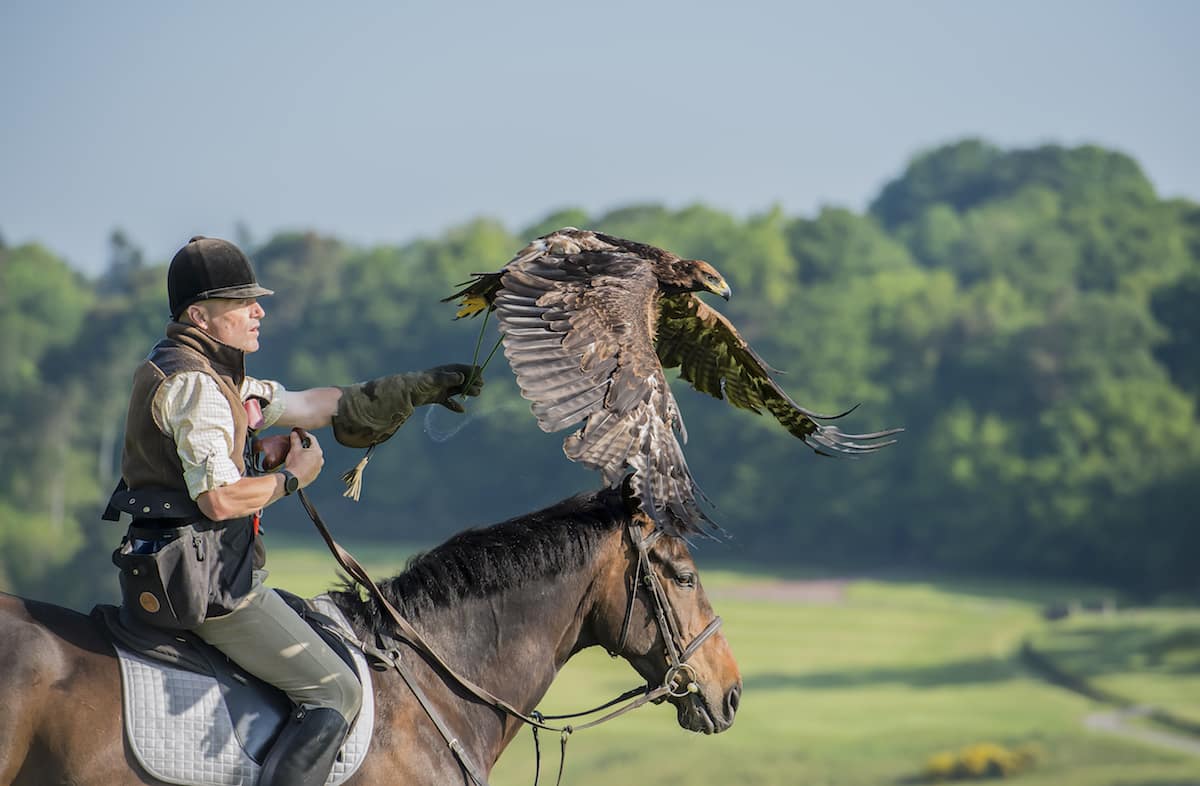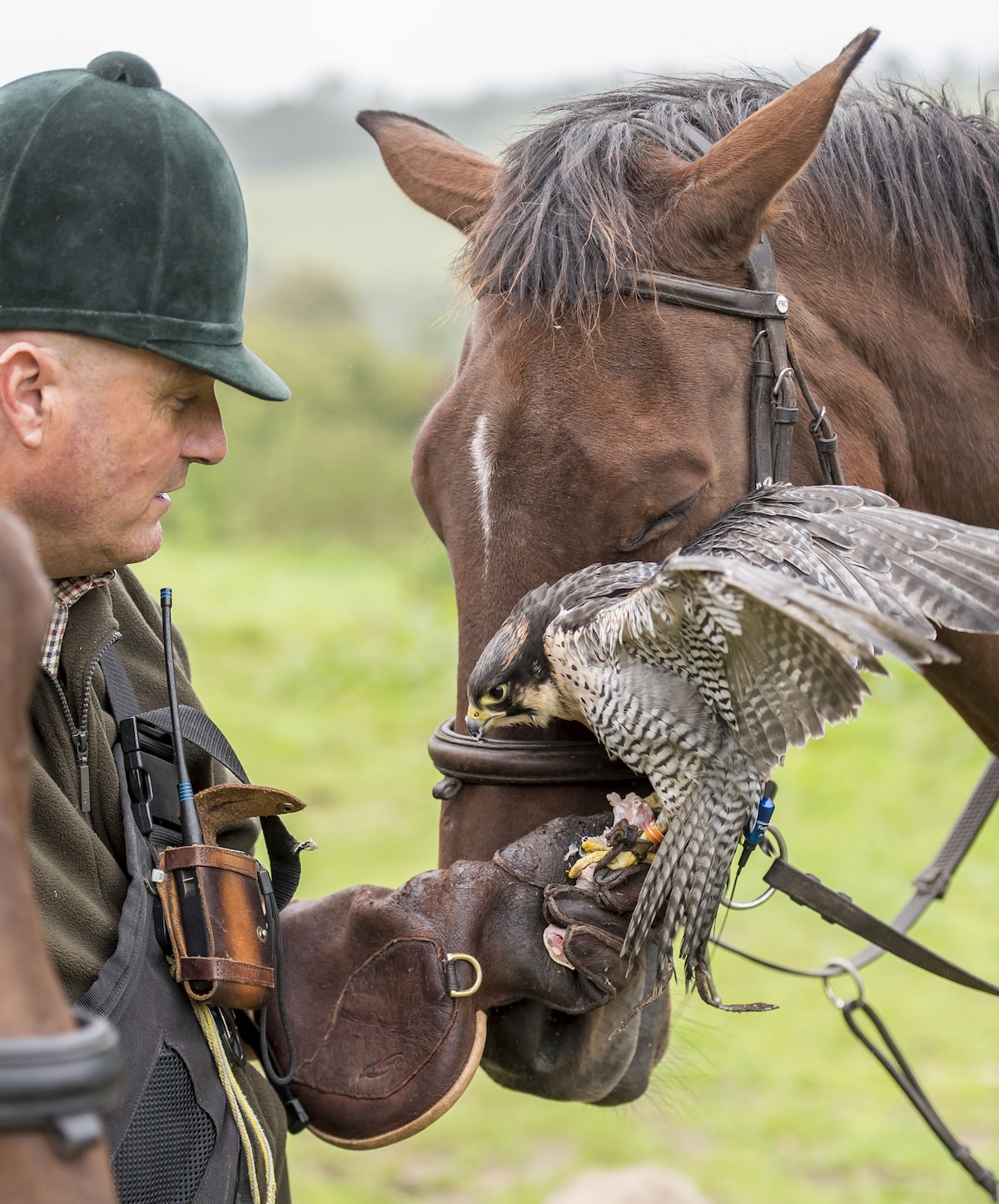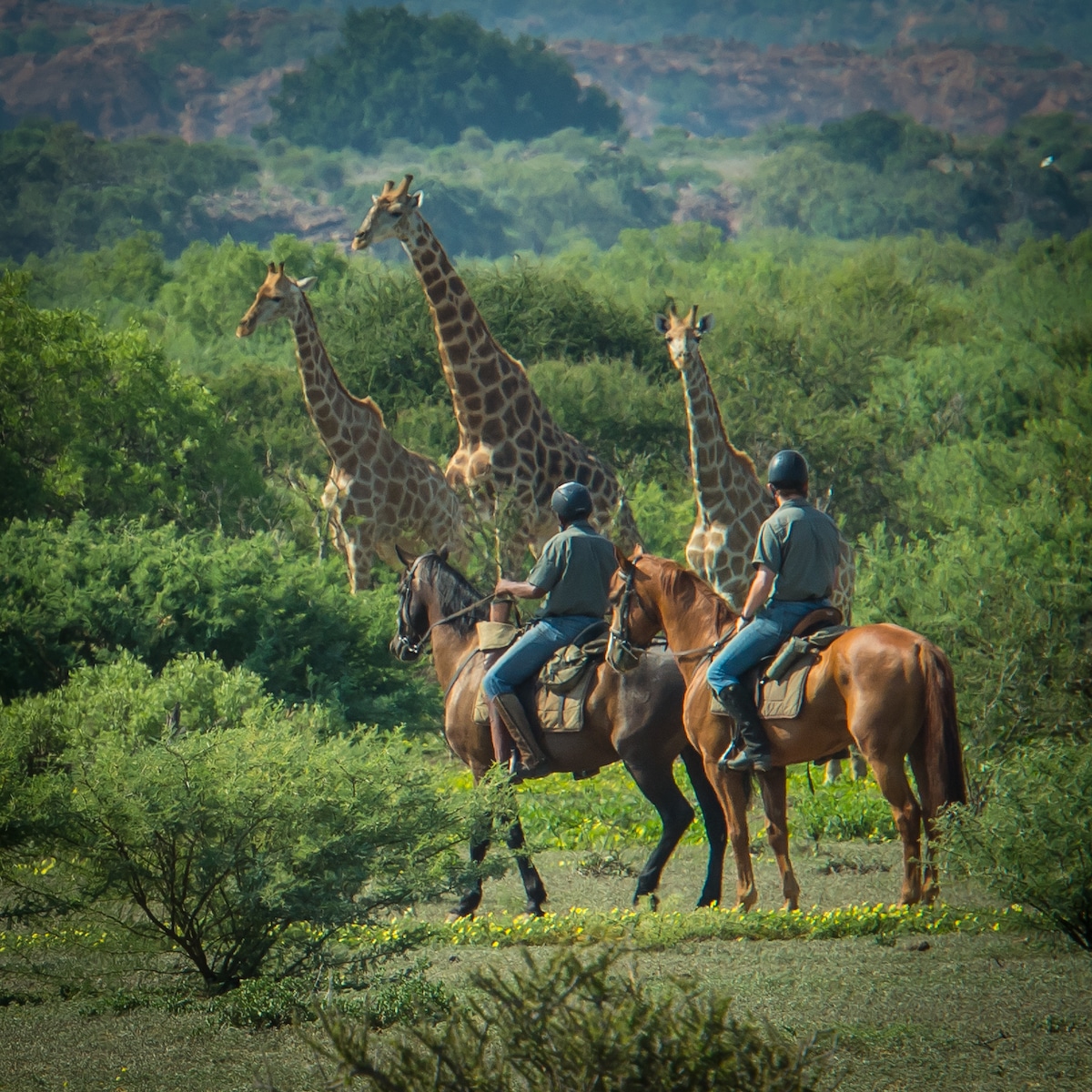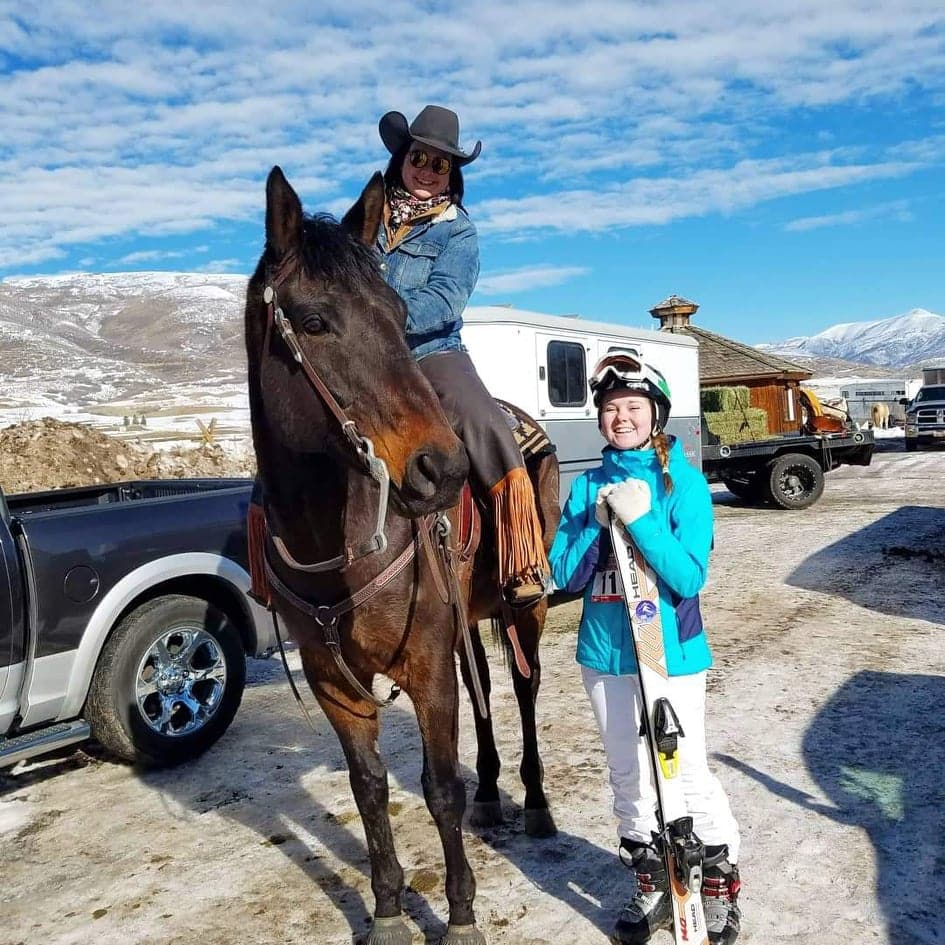Thoroughbreds excelling in unusual sports

Hazel Mansell Greenwood
Ex-racehorses commonly grace dressage arenas, polo fields, stadium jumping courses and even ranching pens. But these aren’t the only places you’ll find them. All over the world, from the open fields of England to the snowy slopes of Utah to the sun-drenched savannas of South Africa, Thoroughbreds are leaving their mark in less-conventional activities and unique sports. We’ll introduce you to OTTBs that have found their niches in three unexpected realms.
Two Ways to Fly: Horseback Hawking
Martin Whitley of Kingsbridge, Devon, in the U.K., loved working with ex-racehorses and loved flying falcons and hawks. It didn’t occur to him to combine his two passions until it happened by chance about two decades ago.
“I was riding a Thoroughbred that I was using as a hunter,” Whitley recalls, “and one of my helpers was having a bit of trouble with a peregrine falcon, and I said to her, ‘Right, hand him up here,’ and there I was.”
Whitley, who enjoyed working with his father’s string of racehorses once they retired from the track, realized he was on to something — the birds and the horses were a natural fit. “It’s one of those careers you have to make up yourself,” he admits. “But enough people were pestering me to give it a go that I realized I could make this a business.”
At Dartmoor Hawking, where Whitley and his wife, Philippa, base their Retired Racehorse Falconry Team, the birds and the horses enjoy a close relationship. “They actively get on really well with each other,” he says. “There’s an actual relationship there. When the birds are loose, they’ll go land on the horses, and the horses don’t mind.”
Whitley believes the Thoroughbred is the choice mount for horseback hawking for reasons beyond his affinity for the breed. “We’ve managed to dispel every major myth about Thoroughbreds, that they’re flighty, they’re stupid,” he says. “They excel in the field — they’re fast!”
Falcons have a level flight speed of more than 40 miles an hour, so being able to follow one’s bird from the ground is critical. Whitley says the hooded falcon rides on the handler’s wrist as he guides the horse one-handed. Once he spots game — typically crows, which Whitley can hunt with falcons as a form of pest control to aid area farmers — the hood comes off, and the falcon takes flight. Here’s where the Thoroughbred’s speed and stamina come into play.
“Once flight begins, you’re running,” Whitley says. “You need to keep up with the bird for everyone’s safety, so I’m watching the sky. My horse needs to be able to find his own feet” in the rough Dartmoor terrain. Once the falcon has brought down its prey, it’s over as quick as it begins: A flat gallop becomes a standstill as Whitley leaps off to tend to his bird.
Guests of Whitley’s Dartmoor Hawking enjoy a morning session learning to handle the hawks, then a simulated mounted hunt in the afternoon, sending eagles after decoys. To keep his mounts fresh, especially those that teach riders, Whitley does a lot of cross-training, including trail hunting, which helps horses learn to behave in a crowd and be aware of their feet, as well as cross-country schooling and a bit of stock work herding sheep, cattle and even wild ponies.
Anyone who’s unexpectedly crossed paths with a large bird while out hacking their Thoroughbred might find it hard to believe, but Whitley has a tried-and-true method for introducing horses to the hawks. “When we’re vetting a new prospect, we do bring a bird along to assess the reaction,” he says. “Sometimes the horse is nervous, but you can see the potential. Only every now and then do you get one that really can’t handle it.”
From there, Whitley builds step by step on the horse’s confidence until working with hawks is just another chapter of these ex-racehorses’ lives. He feeds the hawks in front of the horses, then walks a horse in-hand with a bird on his fist. “The falcons flap, so we start with our steadiest hawks,” he says. “I have a good starter hawk for new horses and a good second hawk. Generally, the bigger the bird, the slower the wing flap, so they’re actually less intimidating.”
While horseback falconry was a favorite pastime of the nobility back in the days of Henry VIII, it’s certainly a unique pairing of unlikely activities in today’s world. Whitley’s made the most of it, producing demos with his string of ex-racehorses and birds all over the U.K. “The Thoroughbreds are just perfect for this,” he says. “There’s nothing as versatile as a well-recycled racehorse.”

Whitley introduces new OTTBs to the hawks slowly to build the horses’ confidence. Hazel Mansell Greenwood
An Adventure Like No Other: Riding Safari
If you’re looking for the ultimate testament to the trainability of the Thoroughbred, look no further than Horizon Horseback, which offers safaris from its two bases in South Africa and Botswana. Guests ride alongside zebra, giraffe, elephant, antelope, hyena and more, and among the many breeds in Horizon’s corral are Thoroughbreds. “We’ve had a few over the years,” says Horizon Horseback co-owner Laura Dowinton, who handles reservations and logistics.
Horizon Horseback’s South Africa base is more permanent and includes herd turnout for the riding string on 300 hectares (about 740 acres), with the entire herd coming in every morning to be checked and fed and individual horses selected for the day’s riding. The Botswana base is a camp-style safari, with horses and riders moving from camp to camp and guests matched with a single horse for the week’s riding. Horizon Horseback staff members keep meticulous records and rotate horses carefully throughout the season to ensure they stay healthy and fit, both physically and mentally.
Certain qualities make a horse particularly well-suited to a riding safari. “We like a responsive horse,” says Dowinton. “They should have a good walk without being a runaway — a horse who likes to walk out and enjoy life is perfect. Horses right around 15.3 are perfect for us, and he should be able to look after himself well out on a ride. Honesty is also an important quality: If a jackal runs out and a horse shies, the horse should not use that as an excuse to run or buck.”
It’s those wildlife encounters, of course, that make a riding safari the ultimate horseback adventure, and the horse can be trained to take any such encounter in stride. “We take new horses out in small groups,” says Dowinton, who usually accompanies these rides on a steady, experienced horse to give the training group confidence. “Giraffe and ostrich, in particular, seem to be the most exciting for a new horse, and the first time you’ll see one, you can feel the horse’s heartbeat against your leg. We let them calmly watch, eat some grass, and they pick up the lead from the other horses very quickly.”
Horses that go on the longer Botswana trek need additional training for elephant encounters. “The lead horse needs to learn how to hold its ground, because the elephants sometimes want to come and take a look,” she says. “Our guides do a great job getting the group into position to watch, but sometimes the matriarchs will come closer — the guide horse has to hold so that everyone else in the line can move away without spooking them all to bolt.”
The Thoroughbreds earn their place in the string like any other horse. Dowinton describes Savannah, a standout in the guest string for her steadiness, and Firefox, a sensitive horse for advanced riders. Their intelligence, however, makes them a particularly lovely ride for both guests and guides. “The Thoroughbreds are so responsive,” says Dowinton. “If you’re going to be on a horse for seven days, you want one that’s intelligent and comfortable to ride, and they’re very well-suited.”

Horizon Horseback staff trains the horses to take wildlife encounters in stride. Courtesy Horizon Horseback Safari
Making the Most of Winter: Skijoring
When Caitlin Cottam of Spanish Fork, Utah, saw a Facebook post advertising a local skijoring event, she decided to give the sport a try — and had just the horse for it in her OTTB Monstruo (Intidab — Runaway Elegance, Runaway Groom), aka “Thai.” Her unraced gelding had done a little bit of everything, from hunter/jumpers to cutting and reining, and dragging a skier at speed down a snowy course on a 30-foot rope didn’t seem like too much of a stretch for his next gig.
“I’m a vet tech, and a couple of the vets I work with are avid skiers,” Cottam says. “So, I convinced them to give it a go.”
A typical skijoring course is a relatively straight shot for horse and rider but a little more complex for the skier, who uses the momentum of the galloping horse to navigate slaloms and jumps while collecting rings along the way. The rope can include knots for grip but no loops or handles — that’s a safety consideration so the skier can let go if things get out of control or if he or she falls.
While some skiers and riders practice independently, coming together at events, Cottam prefers to work closely with her skiers. “It’s really fun to strategize with your skier and work together as a team,” she says. “Our safety really rests in each other’s hands, so communication is key.”
At the upper levels horses typically run with borium on their shoes for added grip and usually sport a snowball pad, as well, to reduce packing — but many also run barefoot, using the horse’s natural grip. Cottam, who’s running in the middle levels where the action is a little slower, can get away with skipping the borium and uses nonstick cooking spray to deter snowballing in Thai’s shoes.
“The course is groomed like a terrain park at a ski resort,” she says. “It’s about 4 inches deep, but packed. The more powder, the more drag on the skier.”
Cottam followed a logical progression of training to prepare Thai for his first skijoring run. “I’d already worked the log drag on him and ponied colts, so he was accustomed to pulling a dally,” she says. She moved to dragging an empty sled to get him used to the sound of something gliding on snow. “The sound of a skier is usually what upsets the horses the most,” she says. “Once he was good with the empty sled, my husband sat in it, and we pulled him around.”
A skijoring run starts from a standstill, so the initial pull to get the skier going takes significant equine strength. Cottam conditions Thai the same way she would for any activity: lots of cardiovascular fitness and muscle development.
“I drag a lot of logs to work on his strength or the sled with some weight on,” she says. “I enjoy trail rides for conditioning miles and work in lots of hills to muscle his topline and hindquarters. I generally try to overcondition him for the job — usually we only do one run a day at an event, but if they’re short on horses, we might do two or three, so I want him to be ready.”
Cottam and Thai have been competing with local skiers for two seasons. When they started, she noticed he was the only Thoroughbred on the circuit; now three or four others run regularly.
Thoroughbreds offer an advantage when it comes to skijoring, Cottam believes. “It’s actually kind of similar to racing, with the standing start and running until you’re told to stop,” she says. “Plus, the environment at an event can be really loud, and a track-broke horse is pretty used to that level of noise. There’s cheering, hooting and hollering, cowbells, sirens, you name it.”

Caitlin Cottam and Thai have been skijoring for two seasons. Courtesy Caitlin Cottam

